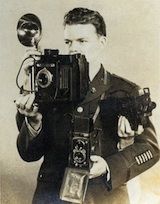- Forum
- Photography and Camera Forum
- Taking the Photo | Editing | The art of Photography!
- Beginner Photography Forum
- gray card and metering mode
gray card and metering mode
Post #109440
using a grey card, what type of meetering should i use? point meetering?
lets say i have a subject at 10 feet on a white background . should i just leave my camera in matrix meetering and set exposure with the gray card in the picture? how large should the gray card cover my view to get an accurate reading? same thing for white balance?
-

- MLKstudios
- Banned
-
- D800 ;-)
- Followers: 72
- Posts: 4480
-
Points:
2
Post #109443
I covered gray card use here:
www.photographytalk.com/photography-arti...tipusing-a-gray-card
HTH
Matthew L Kees
MLK Studios Photography School
www.MLKstudios.com
[email protected]
"Every artist, was once an amateur"
-

- Black Forest
- New Kid On The Block
-
- nikon d300s
- Followers: 5
- Posts: 32
-
Points:
0
Post #109445
-

- lucky1one
- Has the Hang of it
- Canon 1D Mark II
- Followers: 3
- Posts: 74
-
Points:
0
-

- Black Forest
- New Kid On The Block
-
- nikon d300s
- Followers: 5
- Posts: 32
-
Points:
0
Post #109463
TMR 001 wrote:
lucky1one wrote: Hi Matthew. Would you know a company that makes a product that has gray card on one side and a white balance card on the other side? It's a hassle to carry two cards.
What is a white card used for?
I imagine the OP wants the white side for white balance.
-

- Henry Peach
- Apprentice
-
- I currently use a 5DII or Sony Nex-3 most of the time.
- Followers: 50
- Posts: 2925
-
Points:
16
Post #109467
I've been using evaluative metering for 5 or 6 years now. It seems just as consistent as any other reflective metering mode to me. Recently, reading Matthew's comments on evaluative metering mode, I've been metering various scenes using both center weighted and evaluative. I have yet to find one where the reading is different from mode to mode.
As long as the gray card is truly color neutral it would work fine for white balance. Tone doesn't matter.
-

- MLKstudios
- Banned
-
- D800 ;-)
- Followers: 72
- Posts: 4480
-
Points:
2
Post #109501
In my own experience, it is never consistent. My guess is it might pick one image for a reading and another for a second reading -- but I have no way of knowing. No one does.
I've taken Matrix metered pics in controlled lighting environments and gotten various results from the readings.
We know CWA (and spot/partial) are based on the same 18% standard that the gray cards are.
lucky, I sell a dual purpose card, and will be picking some up today. They are based on Robin Myers Imaging DGC-100 (a very accurate WB tool) and I have one side painted using Munsell N4.8 gray (18% reflectance) paint I had an artist mix for me.
There's been a glitch in production (my nephew was the painter and screwed up two batches) but I recently found a replacement. He's an award winning bike painter named Spider.
Let me know if you are interested. Hopefully, Spider's got it right this time.
Matthew
Matthew L Kees
MLK Studios Photography School
www.MLKstudios.com
[email protected]
"Every artist, was once an amateur"
-

- MLKstudios
- Banned
-
- D800 ;-)
- Followers: 72
- Posts: 4480
-
Points:
2
Post #109503
HTH
Matthew L Kees
MLK Studios Photography School
www.MLKstudios.com
[email protected]
"Every artist, was once an amateur"
-

- lucky1one
- Has the Hang of it
- Canon 1D Mark II
- Followers: 3
- Posts: 74
-
Points:
0
-

- MLKstudios
- Banned
-
- D800 ;-)
- Followers: 72
- Posts: 4480
-
Points:
2
Post #109505
When I go back to production level, I sell them for $24.95 with a bamboo lanyard.
Matthew
Matthew L Kees
MLK Studios Photography School
www.MLKstudios.com
[email protected]
"Every artist, was once an amateur"
-

- lucky1one
- Has the Hang of it
- Canon 1D Mark II
- Followers: 3
- Posts: 74
-
Points:
0
Post #109534
A white balance card is used to help you capture colors accurately. By accurately, I mean realistically. To accomplish that, your white balance camera setting must match the color temperature of the light source and condition you were in when you shot the picture.
Different light sources, conditions, and time of day have different temperatures. As such, they cast certain colors. For instance, if you take a picture lit by a household tungsten light bulb, the overall picture may come out orange. If you take a picture in the shade, the image may come out blue. If you take a picture under florescent lighting, your picture may come out green.
There are various ways to ensure you capture accurate colors:
-the easiest and most convenient way is to set your camera to automatic white balance. In majority of time, it works quite well. You let the camera set the white balance for you based on its own calculations. For most people, this method is good enough.
-another way to set white balance is matching the white balance icon in your camera to the lighting condition you're shooting in. For example, if you are shooting on a cloudy day, select the cloud icon in your white balance setting. If you are shooting under tungsten lights, select the light bulb icon in your setting. Remember that you have to change your icon each time the lighting situation changes.
-a third method is to use a white balance card to set custom white balance. You basically take a picture of the card and instruct the camera to set white balance based on that card. As in the previous example, it is important to set a new custom balance whenever the lighting situation changes. This method is more accurate than the others. This is particularly important when color accuracy is vital, such as when you are shooting products for clients.
You can also set the white balance in post production with Photoshop. Like before you first take a picture of the white balance card. (In this case, you don't need to set custom white balance on your camera while you are shooting.) In post production, select the picture in which your white balance card was shoot in. Using the eyedropper tool, click on the image of white balance card. Now, Photoshop will correct the colors based on the image of the white balance card. You can color correct images in batches.
I'm sure there are many other tools and ways to color balance your pictures, such as an Expodisc. When you are shooting with a flash, you can use color gels to correct colors.
Lastly, no one says your images must be color balanced. Sometimes you can use inaccurate colors for creative effects.
-

- MLKstudios
- Banned
-
- D800 ;-)
- Followers: 72
- Posts: 4480
-
Points:
2
Post #109536
I want to emphasize the last point. Sometimes we DON'T want a true WB setting. We want to see the color of the light. It adds a mood to the image.
As a pro, you should KNOW what the color will be even before you shoot. And choose to use it (or not).
Matthew
Matthew L Kees
MLK Studios Photography School
www.MLKstudios.com
[email protected]
"Every artist, was once an amateur"
- Forum
- Photography and Camera Forum
- Taking the Photo | Editing | The art of Photography!
- Beginner Photography Forum
- gray card and metering mode
Latest Reviews
The Fujifilm XT5 is a 40MP mirrorless camera capable of 6.2K video at 30p. With those specs, it’s an ideal choice for photographers needing a camera to pull double duty for imaging and video.
The Canon EOS R100 is an entry-level mirrorless camera introduced in 2023. But just because it’s an entry-level camera doesn’t mean it’s a bare-bones camera. Find out why in this review!
Nikon’s retro-looking Nikon Zfc is anything but retro. Under its classic body is a host of features and amenities that make it a worthwhile compact mirrorless camera for 2024.
The Canon EOS R50 is one of the newest R-system cameras from Canon. Is it worth your money? Find out all the details you need to know in this comprehensive review.
Forum Top Posters
-
1cheapdarkn... 1 post
Latest Articles
Newborn photography requires skill, the right gear, and a lot of patience. This beginner’s guide discusses critical topics that will help you be more prepared for before, during, and after the shoot.
To fill the frame means to expand the footprint of the subject in your shot. Get in close, zoom in, crop the image, or use other techniques to bring the subject to the forefront.
With these simple yet effective beginner photography tips, you can avoid some of the common mistakes beginners make and get improved results with your images.
Urban photography is a genre showcasing features in urban settings. You can photograph people, architecture, mass transit, and many other subjects. Learn how to do so in this guide!
The Nikon D850 might be an older DSLR, but it was ahead of its time when it debuted in 2017. That means it still has plenty of firepower to compete with today’s powerful mirrorless cameras.
The best beginner camera isn’t the same for everyone. That means having choice is of the utmost importance. In this guide, explore five excellent beginner camera options for 2024 and beyond.
Child portrait photography is a unique undertaking requiring special skills and talents to get the best results. Start mastering this photography niche with these essential tips!
The Fujifilm XT5 is a 40MP mirrorless camera capable of 6.2K video at 30p. With those specs, it’s an ideal choice for photographers needing a camera to pull double duty for imaging and video.















